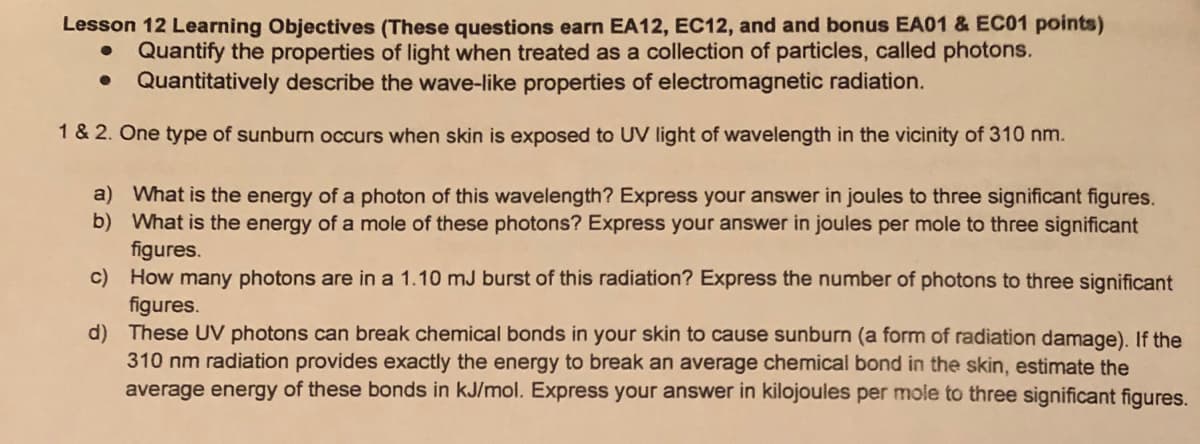1 & 2. One type of sunburn occurs when skin is exposed to UV light of wavelength in the vicinity of 310 nm. a) What is the energy of a photon of this wavelength? Express your answer in joules to three significant figures. b) What is the energy of a mole of these photons? Express your answer in joules per mole to three significant figures. c) How many photons are in a 1.10 mJ burst of this radiation? Express the number of photons to three significant figures. d) These UV photons can break chemical bonds in your skin to cause sunburn (a form of radiation damage). If the 310 nm radiation provides exactly the energy to break an average chemical bond in the skin, estimate the average energy of these bonds in kJ/mol. Express your answer in kilojoules per mole to three significant figures.
1 & 2. One type of sunburn occurs when skin is exposed to UV light of wavelength in the vicinity of 310 nm. a) What is the energy of a photon of this wavelength? Express your answer in joules to three significant figures. b) What is the energy of a mole of these photons? Express your answer in joules per mole to three significant figures. c) How many photons are in a 1.10 mJ burst of this radiation? Express the number of photons to three significant figures. d) These UV photons can break chemical bonds in your skin to cause sunburn (a form of radiation damage). If the 310 nm radiation provides exactly the energy to break an average chemical bond in the skin, estimate the average energy of these bonds in kJ/mol. Express your answer in kilojoules per mole to three significant figures.
Principles of Modern Chemistry
8th Edition
ISBN:9781305079113
Author:David W. Oxtoby, H. Pat Gillis, Laurie J. Butler
Publisher:David W. Oxtoby, H. Pat Gillis, Laurie J. Butler
Chapter20: Molecular Spectroscopy And Photochemistry
Section: Chapter Questions
Problem 5P
Related questions
Question
100%

Transcribed Image Text:Lesson 12 Learning Objectives (These questions earn EA12, EC12, and and bonus EA01 & EC01 points)
Quantify the properties of light when treated as a collection of particles, called photons.
Quantitatively describe the wave-like properties of electromagnetic radiation.
1 & 2. One type of sunburn occurs when skin is exposed to UV light of wavelength in the vicinity of 310 nm.
a) What is the energy of a photon of this wavelength? Express your answer in joules to three significant figures.
b) What is the energy of a mole of these photons? Express your answer in joules per mole to three significant
figures.
c) How many photons are in a 1.10 mJ burst of this radiation? Express the number of photons to three significant
figures.
d) These UV photons can break chemical bonds in your skin to cause sunburn (a form of radiation damage). If the
310 nm radiation provides exactly the energy to break an average chemical bond in the skin, estimate the
average energy of these bonds in kJ/mol. Express your answer in kilojoules per mole to three significant figures.
Expert Solution
This question has been solved!
Explore an expertly crafted, step-by-step solution for a thorough understanding of key concepts.
This is a popular solution!
Trending now
This is a popular solution!
Step by step
Solved in 2 steps

Knowledge Booster
Learn more about
Need a deep-dive on the concept behind this application? Look no further. Learn more about this topic, chemistry and related others by exploring similar questions and additional content below.Recommended textbooks for you

Principles of Modern Chemistry
Chemistry
ISBN:
9781305079113
Author:
David W. Oxtoby, H. Pat Gillis, Laurie J. Butler
Publisher:
Cengage Learning

Chemistry: Principles and Reactions
Chemistry
ISBN:
9781305079373
Author:
William L. Masterton, Cecile N. Hurley
Publisher:
Cengage Learning

Organic Chemistry: A Guided Inquiry
Chemistry
ISBN:
9780618974122
Author:
Andrei Straumanis
Publisher:
Cengage Learning

Principles of Modern Chemistry
Chemistry
ISBN:
9781305079113
Author:
David W. Oxtoby, H. Pat Gillis, Laurie J. Butler
Publisher:
Cengage Learning

Chemistry: Principles and Reactions
Chemistry
ISBN:
9781305079373
Author:
William L. Masterton, Cecile N. Hurley
Publisher:
Cengage Learning

Organic Chemistry: A Guided Inquiry
Chemistry
ISBN:
9780618974122
Author:
Andrei Straumanis
Publisher:
Cengage Learning

Principles of Instrumental Analysis
Chemistry
ISBN:
9781305577213
Author:
Douglas A. Skoog, F. James Holler, Stanley R. Crouch
Publisher:
Cengage Learning


Chemistry: Matter and Change
Chemistry
ISBN:
9780078746376
Author:
Dinah Zike, Laurel Dingrando, Nicholas Hainen, Cheryl Wistrom
Publisher:
Glencoe/McGraw-Hill School Pub Co